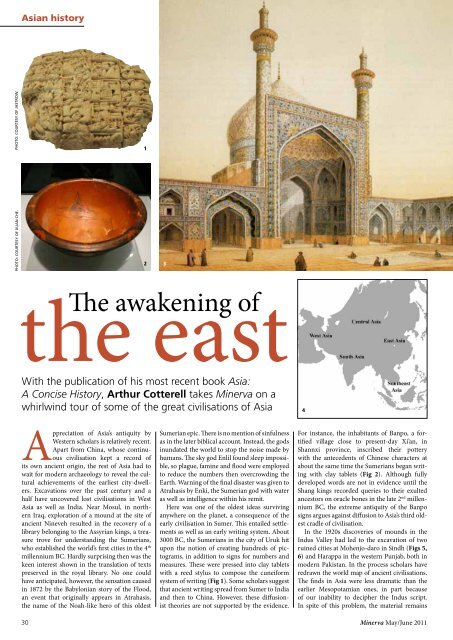Cult of beauty - Minerva
Cult of beauty - Minerva
Cult of beauty - Minerva
Create successful ePaper yourself
Turn your PDF publications into a flip-book with our unique Google optimized e-Paper software.
Photo: courtesy <strong>of</strong> jastrow.<br />
Photo: courtesy <strong>of</strong> xuan che.<br />
Asian history<br />
the<br />
The awakening<br />
east<br />
<strong>of</strong><br />
With the publication <strong>of</strong> his most recent book Asia:<br />
A Concise History, Arthur Cotterell takes <strong>Minerva</strong> on a<br />
whirlwind tour <strong>of</strong> some <strong>of</strong> the great civilisations <strong>of</strong> Asia<br />
Appreciation <strong>of</strong> Asia’s antiquity by<br />
Western scholars is relatively recent.<br />
Apart from China, whose continuous<br />
civilisation kept a record <strong>of</strong><br />
its own ancient origin, the rest <strong>of</strong> Asia had to<br />
wait for modern archaeology to reveal the cultural<br />
achievements <strong>of</strong> the earliest city-dwellers.<br />
Excavations over the past century and a<br />
half have uncovered lost civilisations in West<br />
Asia as well as India. Near Mosul, in northern<br />
Iraq, exploration <strong>of</strong> a mound at the site <strong>of</strong><br />
ancient Nineveh resulted in the recovery <strong>of</strong> a<br />
library belonging to the Assyrian kings, a treasure<br />
trove for understanding the Sumerians,<br />
who established the world’s first cities in the 4 th<br />
millennium BC. Hardly surprising then was the<br />
keen interest shown in the translation <strong>of</strong> texts<br />
preserved in the royal library. No one could<br />
have anticipated, however, the sensation caused<br />
in 1872 by the Babylonian story <strong>of</strong> the Flood,<br />
an event that originally appears in Atrahasis,<br />
the name <strong>of</strong> the Noah-like hero <strong>of</strong> this oldest<br />
30<br />
1<br />
2<br />
3<br />
Sumerian epic. There is no mention <strong>of</strong> sinfulness<br />
as in the later biblical account. Instead, the gods<br />
inundated the world to stop the noise made by<br />
humans. The sky god Enlil found sleep impossible,<br />
so plague, famine and flood were employed<br />
to reduce the numbers then overcrowding the<br />
Earth. Warning <strong>of</strong> the final disaster was given to<br />
Atrahasis by Enki, the Sumerian god with water<br />
as well as intelligence within his remit.<br />
Here was one <strong>of</strong> the oldest ideas surviving<br />
anywhere on the planet, a consequence <strong>of</strong> the<br />
early civilisation in Sumer. This entailed settlements<br />
as well as an early writing system. About<br />
3000 BC, the Sumerians in the city <strong>of</strong> Uruk hit<br />
upon the notion <strong>of</strong> creating hundreds <strong>of</strong> pictograms,<br />
in addition to signs for numbers and<br />
measures. These were pressed into clay tablets<br />
with a reed stylus to compose the cuneiform<br />
system <strong>of</strong> writing (Fig 1). Some scholars suggest<br />
that ancient writing spread from Sumer to India<br />
and then to China. However, these diffusionist<br />
theories are not supported by the evidence.<br />
4<br />
For instance, the inhabitants <strong>of</strong> Banpo, a fortified<br />
village close to present-day Xi’an, in<br />
Shannxi province, inscribed their pottery<br />
with the antecedents <strong>of</strong> Chinese characters at<br />
about the same time the Sumerians began writing<br />
with clay tablets (Fig 2). Although fully<br />
developed words are not in evidence until the<br />
Shang kings recorded queries to their exulted<br />
ancestors on oracle bones in the late 2 nd millennium<br />
BC, the extreme antiquity <strong>of</strong> the Banpo<br />
signs argues against diffusion to Asia’s third oldest<br />
cradle <strong>of</strong> civilisation.<br />
In the 1920s discoveries <strong>of</strong> mounds in the<br />
Indus Valley had led to the excavation <strong>of</strong> two<br />
ruined cities at Mohenjo-daro in Sindh (Figs 5,<br />
6) and Harappa in the western Punjab, both in<br />
modern Pakistan. In the process scholars have<br />
redrawn the world map <strong>of</strong> ancient civilisations.<br />
The finds in Asia were less dramatic than the<br />
earlier Mesopotamian ones, in part because<br />
<strong>of</strong> our inability to decipher the Indus script.<br />
In spite <strong>of</strong> this problem, the material remains<br />
<strong>Minerva</strong> May/June 2011

















